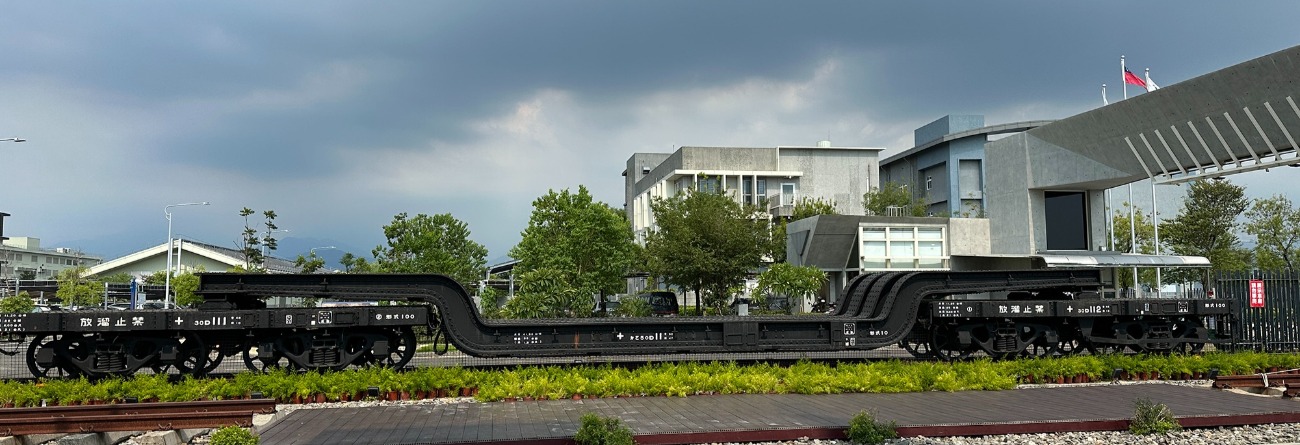30ES32375型工程宿營車

30ES32375型工程宿營車
木造客車因材質與結構設計關係,易受白蟻蟲蛀維持不易,,臺鐵自1950年代積極思考將原有大量的木造客車改造為鋼體車身,至1957年12月發生死傷慘重的鶯歌列車出軌翻覆事故後,計畫加速進行。1958年起採規格化方式,擬定木造車鋼體化更新計劃,將舊有車身長度為 17公尺級各型木造客車轉向架及部分底架構件留用,但車體全部重造,更新成鋼體客車。1965年二百餘輛全數完成,比原定計畫提前3年。
這批木造車鋼體化更新客車最後大多被解體,目前留存的30ES32375號,更新前原車為大型木造客車30SP22037號,1965年10月改造出廠,變更為30SP32375號。1970年前後轉向架換裝為TR-32型,成為甲種客車車號加註為30SP32375甲。多年載客使用之後,約在1994年左右改造為烏日鋼梁隊用工程宿營車型號改為30ES32375。目前塗裝為浪漫藍,雖然車內已與原況不同,但仍相當珍貴。
Type 30ES32375 track maintenance campervan
Due to the material and structural reasons, wooden body passenger cars are vulnerable to termites and difficult to maintain. Moreover, they are easy to be completely destroyed in case of train accidents, which is very unsafe. In the 1950s, TR actively planned to replace a large number of original wooden body passenger cars with steel bodies. It was not until December 1957, after the fatal accident of Yingge train derailment and overturning accident, that the project was accelerated. In 1958, the standardization method was adopted, and the renewal plan of "All Steel Body Rebuild Project" was drawn up. Except for the bogies and some underframe components of the old wooden coach that was reused, the rest of the car bodies were completely rebuilt into steel structures. In 1965, more than 200 passenger cars were completed, 3 years ahead of the original plan.
Most of these cars are scrapped today. The second class coach 30SP32375, originated from the original wooden coach 30SP22037, was rebuilt to steel body in October 1965. Around 1970, the 2 bogies were replaced with TR-32 type, reclassified as class A passenger car for higher speed operation. After decades of carrying passengers, it was modified into an track maintenance campervan 30ES32375 for the Wuri Steel Bridge Maintenance Shop around 1994. At present it is painted in "romantic blue" as its final revenue service era. Although the interior of the car is different from its original design, it is still quite precious.
30ES32375形工事用宿泊車
木造客車は、その材質と構造設計によりシロアリの被害を受けやすく、保守が困難で、事故発生時には破損が激しいという安全上の問題があります。台湾鉄路局は1950年代より、既存の大量の木造客車の鋼体化改造を検討し始めました。さらに1957年12月に死傷の甚大な鶯歌列車の脱線横転事故を受け、早急に計画が進められました。1958年より標準化の方式が採られ、木造車両の鋼体化改造計画を定め、車体の長さが17mクラスの旧型の各種木造客車は、台車と一部の台枠部材を残し、車体全てが鋼材に作り変えられ、鋼体客車となりました。1965年、当初の計画より3年早く、200両余りの改造が完成しました。
木造車両から鋼体化改造されたこれらの客車は、最終的にはほとんどが解体されてしまいましたが、現存している30ES32375号は、大型木造客車の30SP22037号を改造したもので、1965年10月に出場し、30SP32375号に変更されました。1970年頃には台車がTR-32形に変更されて甲種客車となり、車両番号が30SP32375甲に変更されました。長年にわたり客車として使用された後、1994年頃に烏日橋けた保守基地用の宿泊用工事車に改造され、車種番号が30ES32375に変更されました。現在は青色に塗装され、車内の様子も当時とは異なりますが、大変貴重な鉄道文化財です。
30ES32375형 공정 숙영차(*휴식 차량)
목조 차량은 재질과 구조설계로 인해 흰개미에 취약하여 유지하기가 쉽지 않고, 사고 시 완전 분해되기 쉬우며 안전하지 않습니다. 대만 철로는 1950년대부터 대량의 목조 차량을 강체 차체로 개조하는 것을 적극 검토하였습니다. 그리고 1957년 12월 피해가 심각했던 잉거(鶯歌) 열차 사고 후 계획 실행에 박차를 가했습니다.
1958년부터 규격화 방식을 채택하여 목조 차량의 강체화 계획을 수립하였습니다. 기존 차체 길이가 17m급인 각 목조차량 대차 및 특정 하부 프레임은 그대로 사용하였으나, 차체는 모두 재제작하여 강체 차량으로 업그레이드하였습니다. 1965년에는 기존 계획보다 3년 앞당겨 200여 대를 모두 완성했습니다.
이 목조 철체화 업그레이드 차량들은 결국 대부분 해체되었으며, 현재 남아 있는 30ES32375호는 업그레이드 이전에는 대형 목조 차량 30SP22037호였으나 1965년 10월 개조 출고되어 30SP32375호로 변경되었습니다.
1970년경 대차는 TR-32로 교체되었으며 갑종(甲種客車)객차가 되어 차량 번호는 30SP32375A로 표시되어 있습니다.
다년간 승객을 태우고 사용한 후 1994년경 우르 강량팀 용 공정 숙소 차량으로 개조, 30ES32375로 변경되었습니다. 현재 로맨스 블루색으로 도장되어 있으며, 차량 내부는 기존과는 다르지만, 여전히 소중합니다.


